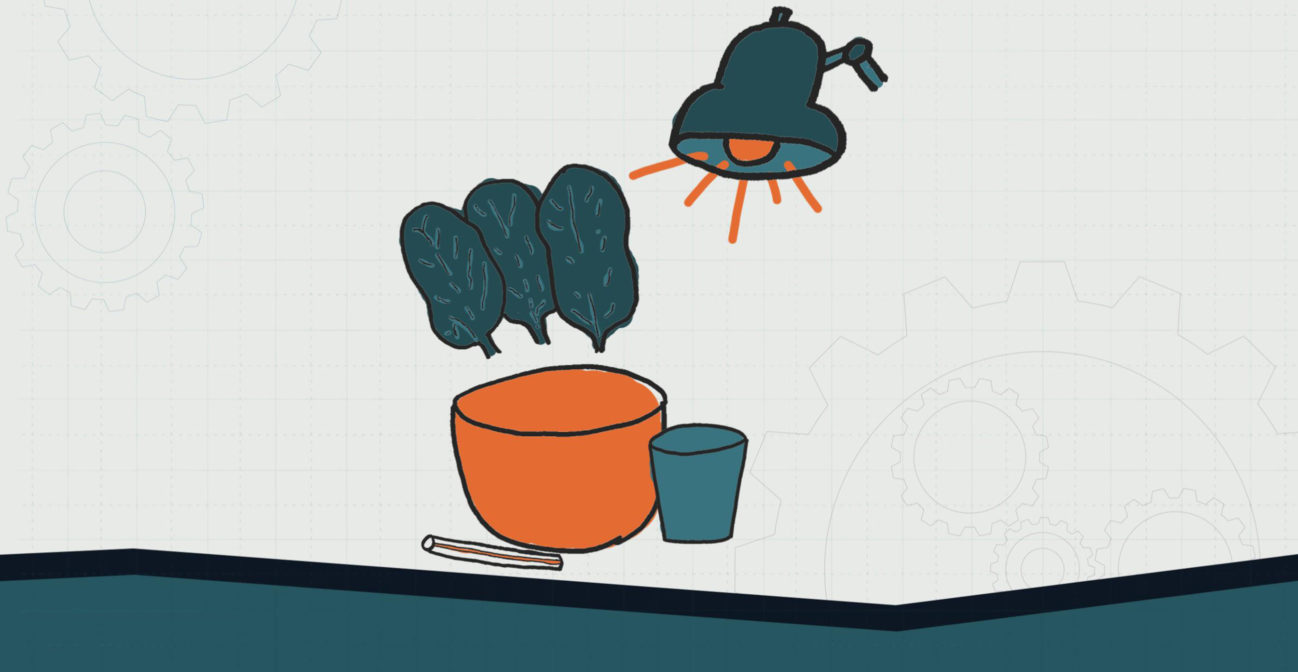Join us for conversations that inspire, recognize, and encourage innovation and best practices in the education profession.
Available on Apple Podcasts, Spotify, Google Podcasts, and more.

MIDDLE SCHOOL – LEVEL 1
Photosynthesis is the process through which plants convert sunlight into energy. This experiment allows you to see with your own eyes the way this process works. As plants convert the sunlight to sugar, they let off the byproduct of the oxygen we breathe.
MATERIALS NEEDED:
❏ Baking soda
❏ Scale
❏ Dish soap
❏ A lamp with 100-w bulb or sunlight
❏ A straw
❏ Spinach
❏ Clear plastic cup
❏ Cooking syringe without needle
DIRECTIONS:
OBJECTIVE: Students will be able to construct scientific explanations of photosynthesis and its role in cycling matter and energy.
ESSENTIAL QUESTION(S):
1. Show students a picture of the self-contained terrarium, constructed by David Latimer, that is over 50 years old!
a. It has been watered only once in 58 years
2. Ask students how is this plant surviving? What does this plant need in order to survive?
1. Perform a tealight candle-and-plant demo.
a. Materials needed
i. 2 candles
ii. Small plant
iii. Two containers large enough to cover the plant.
1. Containers should be same-size (for control purposes)
b. Light both candles
c. Place one candle with the plant and the other alone.
d. Cover both setups at the same time.
2. Ask students to observe the demo
a. Students should record observations
b. It should occur that the candle without the plant goes out first
3. Ask students to review their observations and reflect
a. Why did one candle go out first?
b. What effect does the plant have? Why? How?
4. Teacher should intentionally refuse to answer students questions
a. Encourage students that their questions are good, but we must do more research and experimentation to find our answers
b. Pretend you don’t know
5. Evaluate
a. Students observations of the phenomena
b. Reflections
1. Have students perform the spinach-leaf photosynthesis lab
2. Students should use their data to reason about photosynthesis
a. Why do the leaves float and sink?
3. Students should try and make a connection between the phenomena they observed with the candle and the spinach leaves
a. How are they related?
b. Similarities/differences
4. Evaluate
a. Students experimental design and process
b. Use of evidence for reasoning
1. Students should try to piece together from experimentation and prior knowledge what occurred in the above two experiments
a. There should be a series of teacher and student generated questions that are still not answered
i. How do plants grow?
ii. Why do the leaves float and sink?
iii. What to flames need to stay lit?
iv. And many others.
b. Allow students time to discuss these and transition into teacher-led instruction or research
2. Provide students a variety of opportunity to learn about photosynthesis
a. Textbooks
b. Notes
c. Visual diagrams
d. Engaging video on photosynthesis
e. More complex explanation
3. Allow students to construct slides to look under the microscope, with direction
a. Students should dissect a spinach leaf by folding it and removing the top layer of the bottom side of the leaf
b. Alternatively, you may use clear nail polish and paint the bottom side of the leaf.
c. Gently remove the layer of nail polish and use under the microscope.
d. Students should be looking for the openings in the leaf (stomata)
4. Ask students to synthesize the information on photosynthesis
a. Produce a diagram of the photosynthetic process
b. Or produce a flow map
1. Have students revisit the data from the two demos above
a. Students use their new insight into photosynthesis to revise their conclusions based on their evidence and interpretation of data.
2. Evaluate
a. Teacher may also choose to do another experiment using elodea plants
b. Students use their evidence to construct an explanation of photosynthesis for the elodea plant
c. Teacher asks students to create and explanation of the self-contained terrarium above.
i. How does matter and energy in the closed system transfer in and out of the plant
NGSS CONNECTION:
MS-LS1-6. Construct a scientific explanation based on evidence for the role of photosynthesis in the cycling of matter and flow of energy into and out of organisms.
COMMON CORE CONNECTION:
ELA/Literacy
SL.8.5 Integrate multimedia and visual displays into presentations to clarify information, strengthen claims and evidence, and add interest.
RST.6-8.1 Cite specific textual evidence to support analysis of science and technical texts.
RST.6-8.2 Determine the central ideas or conclusions of a text; provide an accurate summary of the text distinct from prior knowledge or opinions.
WHST.6-8.2 Write informative/explanatory texts to examine a topic and convey ideas, concepts, and information through the selection, organization, and analysis of relevant content.
WHST.6-8.9 Draw evidence from informational texts to support analysis, reflection, and research.
Mathematics
6.EE.C.9 Use variables to represent two quantities in a real-world problem that change in relationship to one another; write an equation to express one quantity, thought of as the dependent variable, in terms of the other quantity, thought of as the independent variable. Analyze the relationship between the dependent and independent variables using graphs and tables, and relate these to the equation.
DOK:
Level 3: Strategic Thinking
Level 4: Extended Thinking